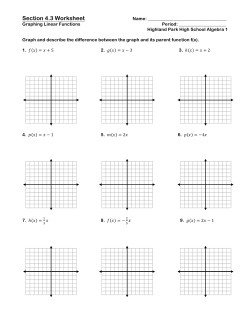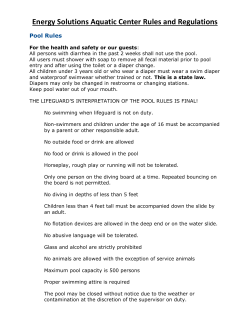
Automated Drowning Detection and Security in Swimming
ISSN(Online): 2320-9801
ISSN (Print): 2320-9798
International Journal of Innovative Research in Computer
and Communication Engineering
(An ISO 3297: 2007 Certified Organization)
Vol. 3, Special Issue 2, March 2015
Automated Drowning Detection and Security
in Swimming Pool
S.Hemalatha1, P.Nandhini2, J.Vimala3, V.Ramesh4
U.G Students, Dept. of Electronics and communication, Narasu’sSarathy Institute of Technology, Salem, India1,2,3
Assistant Professor, Dept. of Electronics and communication, Narasu’sSarathy Institute of Technology, Salem, India4
ABSTRACT: Swimming pool surveillance systems plays an essential role in safeguarding the premises. The main
purpose of this project is to design a safety swimming pool. We present in this paper human movement approach to
detection of drowning incidents in swimmingpools at the earliest possible stage.This is done by preventing the children
from drowning in the swimming pool by lifting the iron plate.The proposed approach consists of two main parts: The
LASER and LDR are the main thing and an iron plate for inclination.Compared with the swimming pool drowning
monitoringsystem based on video technology, the demo system based on human movements hasan advantageof
convenience, cost saving, and simple algorithm.
KEYWORDS: Laser, LDR, Inclination, Iron plate, Monitoring.
I.
INTRODUCTION
Swimming is a favorite exercise, but in the water, beginners often cannot be free to breathe action and cause
choking water, then loss of balance and cause a drowning accident. Somespecial circumstances, such as cramps, collide
with each other, disease or mental stress, and so on, may also cause swimmer drowning. Drowning is a leading cause of
death and disability for children. Worldwide, drowning produces a higher rate of mortality than any other cause of
injury in children less than 15 years of age. Young children under the age offive are at particular risk, suffering the
highest drowning mortality rates worldwide. According to the Centers for Disease Control and Prevention,
approximately one thousand children die from drowning annually in the world. Young children under the age of five
are at particular risk, suffering the highest drowning mortality rates worldwide. In this project to avoid drowning
accidents automatically by using the iron plate. The earliest swimming alarm system appears in the 1976, then there are
some patent applications, but due to various reasons, these techniques are not popular. In 2001, the French Vision IQ
company produced the world's first set of drowning alarm system Poseidon, this is the first commercial promotion
system. In 2003, Singapore Nan yangUniversity of Technology design DEWS. Swimming pool drowning monitoring
system based on video technology is mostly reported in the literature. There are three kinds drowning monitoring
system according to the different position of the camera. One is that the camera is mounted on the underwater
swimming pool wall, then monitor underwater swimmer status. A limitation of this equipment is that if too much
swimmers, occlusion problem will appear. The other is that the camera is mounted upon the water, and monitors the
swimmer posture change. The reaction and refraction of light and water wave interference will affect the image quality,
and drowning man feature this method detected is not easy to distinguish swimmers and divers obviously.The third is a
combination of the two, underwater camera and aerial camera matched, monitoring the swimmer posture.
II.
PREVIOUS SYSTEM FOR DROWNING
The block diagram of the previous drowning detection in the swimming pool figure [1] is given below. In this
technology they are using the wearable device and then the video cameras are used. The device we designed is wear on
the wrist and move in large amplitude along with the wrist when human is swimming in the water, and the data
acquired from accelerator will dramatic changes. If human is drowning in water, his or her wrist almost motionless, and
the data acquired from accelerator will have only small changes due to water movement. Drowning detection method
uses threshold.
Copyright to IJIRCCE
www.ijircce.com
17
ISSN(Online): 2320-9801
ISSN (Print): 2320-9798
International Journal of Innovative Research in Computer
and Communication Engineering
(An ISO 3297: 2007 Certified Organization)
Vol. 3, Special Issue 2, March 2015
Fig. 1 wrist drowning detection device
Wearable drowning monitor device can detect drowning accident and alarm. The device has seven main modules,
including microprocessor, power module, SD memory card module, LED warning module, acceleration sensor module,
water pressure sensor module, and keys module. The red LED is used for drowning warning. One blue LED is used to
get the work status of the device which will ash every few seconds in order to save the precious energy. Because LED
light-emitting angle generally relatively small, 5 red LED lights of upward and around direction is installed to make
LED alarm signal clear. Two keys are designed on the demo device. One is the switch for power. First, data from water
pressure sensor is used to judge whether the human body in the water,if the body in the water,then start downloading
judgment process.Then, analog signal obtained from the three axis acceleration sensor is converted to digital signal and
three axis acceleration valuesare gained. Human motion changes can be obtained through analysis then we can
determine the human body is in the independent state of motion or drowning. In the demo system, acceleration data is
analyzed every 25 seconds and if human has less than twice elective movement, we can judge that he or she has
drowning occurs.
III.
PROPOSED DROWNING DETECTION
The proposed system block diagram figure[2] shows given below. In this project we are going to design a safety
swimming pool by using a light source.In the proposed method the human identification in the swimming pool depends
Copyright to IJIRCCE
www.ijircce.com
18
ISSN(Online): 2320-9801
ISSN (Print): 2320-9798
International Journal of Innovative Research in Computer
and Communication Engineering
(An ISO 3297: 2007 Certified Organization)
Vol. 3, Special Issue 2, March 2015
on the LDR and laser.First, data from water pressure sensor is used to judge whether the human body in the water, if
the body in the water,then start downloading judgment process.The iron metal plate is placed in the floor of the
swimming pool. The laser and the LDR source will be placed in the side of the wall. Here we are using ATmega8l
microcontroller to control the whole process. Embedded c language is used for thecoding. Initially he laser source
which spreads over the swimming pool and the LDR which sense the laser light and which produces the resistance
value. Depends onthe resistance value the process has been taken.When the LDR value will be kept constant then the
alarm will be activated.The resistance value will be changed with respect to the human movement. The message will be
send to the administration by using the GSM service.After 30 seconds there is no change which means the plate will
liftautomatically using the motor and motor drive.The human has safe in this technique.
BLOCK DIAGRAM:
MOTOR
MOTOR
DRIVE
ALARM
LASER
LDR
ATmega8l
RS232
POWER
SUPPLY
GSM
Fig.2 Block diagram for drowning detection system in swimming pool
BLOCK DIAGRAM DESCRIPTION
The proposed project consists of following modules
A.
B.
C.
D.
Laser &LDR implantation
Timer circuit for ATMEGA8
GSM module
Buzzer and inclination circuit
Copyright to IJIRCCE
www.ijircce.com
19
ISSN(Online): 2320-9801
ISSN (Print): 2320-9798
International Journal of Innovative Research in Computer
and Communication Engineering
(An ISO 3297: 2007 Certified Organization)
Vol. 3, Special Issue 2, March 2015
A.
LASER &LDR IMPLANTATION MODULE
1.
2.
Laser
LDR
LASER:
By using the laser source we can generate the laser light. The laser light which spreads over the water in the swimming
pool. The laser source which is placed in the side wall of swimming pool.
LDR:
Light depending resistance. The LDR which is used to measuring the resistance value of laser light. The resistance
value is not constant the value will be changed depending on the movement of human and then the LDR is fixed side of
the wall.
B.
TIMER CIRCUIT FOR ATMEGA8:
ATmega8 is the microcontroller, that controller has peripheral features like inbuilt ADC, required to get the signals
from the sensors. Maximum clock frequency is 20MHz and hence faster than 8051. It is based on RISC and Hardware
architecture and hence even faster. Embedded C is used for programming the microcontroller. The block diagram the
output is passed to the controller pin then 1v output is given to the motor circuit .Here the motor driver converts the 1v
to12v and then the motor runs automatically then the iron plate lifted automatically.
C.
GSM MODULE:
RS232 INTERFACE:
The serial/Column port of the computer is used for communication with the hardware. The serial port of the computer
uses RS232standard for communication.RS232 standard voltages are not compatible with conventional TTL / CMOS
circuits. Hence IC MAX232 is used for voltage conversion between RS232 port and the microcontroller.MAX232
enables full duplex communications, while doing the necessary voltage conversions.
GSM:
GSM (Global System for Mobile communication) is a digital mobile telephony system. With the help of GSM module
interfaced, we can send short text messages to the required authorities as per the application. This technology enables
the system a wireless system with no specified range limits. This is a plug and play GSM Modem with a simple to
implement RS232 and TTL serial interface. It is used to send SMS, make and receive calls, and do other GSM
operations by simple AT commands through a serial interface from microcontrollers and computers. It uses the SIM300
module for all its GSM operations. Thus GSM Module is connected to the controller and transmits the incoming
messages to the controller. It also receives the messages from controller.GSM uses a variation of time division multiple
access (TDMA) and is the most widely used of the three digital wireless telephony technologies (TDMA, GSM, and
CDMA). GSM digitizes and compresses data, then sends it down a channel with two other streams of user data, each in
its own time slot. It operates at either the 900 MHz or 1800 MHz frequency band.
D.
BUZZER AND INCLINATION CIRCUIT:
The alarm is activated when the LDR value will be not changed depends on the human movement. The LDR resistance
value will be increased which means there is any human is presented in the swimming pool. Then the alarm is
activated. After the 30 seconds there is no change in the LDR value means the iron plate is lifted automatically.
IV.
CONCLUSION
In future the system can be modified by using the various detection technologies.If the swimmer has a long time rest,
the device will give positive judgment. Problems such as device sealed and batteries power supply, andso on, need to
be further studied. The new type of laser used in the water has been studied.
Copyright to IJIRCCE
www.ijircce.com
20
ISSN(Online): 2320-9801
ISSN (Print): 2320-9798
International Journal of Innovative Research in Computer
and Communication Engineering
(An ISO 3297: 2007 Certified Organization)
Vol. 3, Special Issue 2, March 2015
REFERENCES
[1]Jianzhongwu_, jianpingcai_, meimeihuo, minghuiwu,jinyingzhou” a wearable early monitoring and alarming device forswimming pool drowning
incidents” journal of computational information systems 9: 21 (2013) 8619{8627
[2]Howlungeng, karanntoh, weiyunyau, junxianwang, dews: a live visual surveillancesystem for early drowning detection at pool, ieee transactions
on circuits and systems forvideo technology, 2008, 18 (2): 196-210.
[3]Zhiyuzhou, jianxinzhang, li fang, object tracking based on dynamic template andmotion prediction. journal of computational information systems,
2009, 5 (6), 1841-1846.
[4]Caixiaoyang, chenwenkai, lei fei, application of image restoration based on robust estima-tion in drowning warning system, digital media and its
application in museum &heritages,second workshop on , 2007, 12, 33-35.
[5]Wenmiaolu, yap-peng tan, a vision-based approach to early detection of drowning incidents inswimming pools, IEEE transactions on circuits and
systems for video technology, 2004, 14 (2):159-178.
[6] Weiss, J., Gardner, H. G., Baum, C. R., Dowd, M. D., Durbin, D. R., Ebel, B. E., et al. Policystatement-prevention of drowning. Pediatrics, 2010,
126 (1): 178-185.
Copyright to IJIRCCE
www.ijircce.com
21
© Copyright 2025









